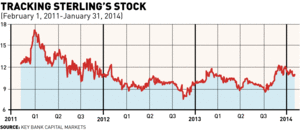
Executives of Sterling Construction Co., a Houston roadbuilder, are likely paying close attention to the transportation funding debate in Washington as they push for new work to restore a struggling balance sheet.
Investors and analysts of the publicly held contractor hope so, too, after a series of disappointing quarters fueled by project writedowns and what observers say were management missteps.
Recent company statements provide some glimpses of Sterling's efforts to reverse the slide, but it won't report its latest results and future guidance in detail until March 17.
In a Feb. 25 article posted on stock-tracking online site Seeking Alpha, investor Igor Novgorodtsev, a Lares Capital LLC hedge fund manager, notes that while Sterling (STRL:NASDAQ) has had a "poor track record of the management overpromising and underdelivering as well as conveniently blaming its predecessors, the payoff, if the management finally keeps its promises, could be tremendous."
The firm ranks at No. 92 on ENR's list of the Top 400 Contractors, based on reported 2013 revenue of $630.5 million, with 98% in transportation work.
Sterling's early guidance, issued on Feb. 4, indicates the news will be mixed. It notes improved bookings, both in dollar amounts and gross margins, with 2013 backlog at $600 million.
But the firm expects a loss of up to $38 million for its fourth quarter, ended Dec. 31,
 |
| MacKenna |
The firm has not disclosed project names or details, but online commenters to Novgorodtsev's article speculate they involve work on the Chisholm Trail Parkway and Manor Expressway, all booked in 2010 and 2011.
According to one commenter—likely an investor—those jobs and several others, were booked without "adequate controls in place for reviewing bid estimates on large projects." The commenter raises concern about potential writedowns on 2012-booked projects that could limit the firm's bonding potential.
Saagar Parikh, an E&C analyst for KeyBanc Capital Markets, said on Feb. 4 he expected Sterling to be "susceptible to cost volatility due to the risk within its backlog," but was "surprised by the magnitude" of the results revision.
Parikh had anticipated a $1.2-million profit.
Sterling was profitable until the recession, said Novgorodtsev, and had "remarkably stable gross profit margin around 10% until 2011."
It then faced stalled state spending and bidding against new kinds of competitors at "rock-bottom prices," he said.
Instead of pulling back to protect its margins, he said, the firm continued "an acquisition spree" and kept up aggressive bidding.
MacKenna, a former executive vice president of Skanska USA Civil who was recruited to Sterling in 2012, believes the firm has turned the corner.
In the Feb. 4 statement, he said completion of the troubled projects, improved bookings, resolution of a financial covenant breach and management changes "should translate into a significantly improved financial performance in 2014."
MacKenna has hired a bevy of seasoned executives, from Skanska and other industry firms. They include Peter Holland, formerly a top exec at contractors Satterfield & Pontikes and Parsons, to run its beleaguered Texas unit.
Sterling also has added three new independent directors, including Paul J. Varello, founder and chairman of Commonwealth Engineering & Construction, which specializes in oil-and-gas and energy sectors, and earlier, Charles Patton, president and chief operating officer of Appalachian Power Co., a unit of utility AEP.
The firm has reported recent project wins in Nevada and at Los Angeles International Airport, and one observer says it is eyeing bigger projects with higher margins.
That could include potential in the growing Texas P3 transportation market and work flowing from the $2-billion state bond passed in 2012 for water and wastewater treatment projects.
"We have a mixed to positive outlook on the US transportation infrastructure space, seeing increased levels of bidding activity, firmer prices and initial signs of award activity starting to occur," says KeyBanc's Parikh. "The end market has started to experience benefits of state budget surpluses, flowthrough of MAP21 spending and continued user fees and special tax initiatives.”






Post a comment to this article
Report Abusive Comment